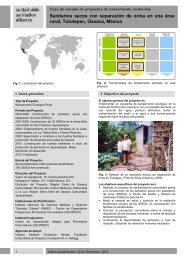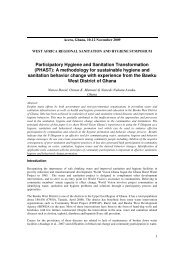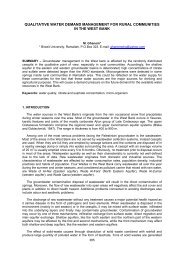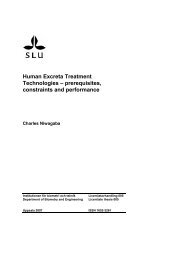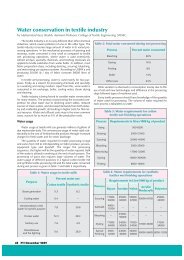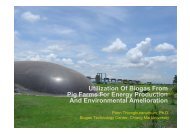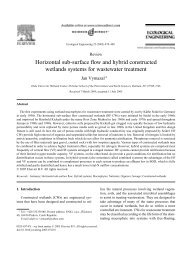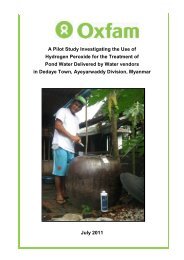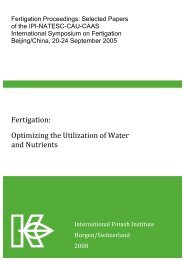Compilation of 13 factsheets on key sustainable sanitation ... - SSWM
Compilation of 13 factsheets on key sustainable sanitation ... - SSWM
Compilation of 13 factsheets on key sustainable sanitation ... - SSWM
You also want an ePaper? Increase the reach of your titles
YUMPU automatically turns print PDFs into web optimized ePapers that Google loves.
disappearing <str<strong>on</strong>g>of</str<strong>on</strong>g> glaciers in the Andes – which is currently the source<br />
<str<strong>on</strong>g>of</str<strong>on</strong>g> water supply for Lima. More photos showing water scarcity in<br />
Lima: www.flickr.com/photos/gtzecosan/sets/7215762951163<str<strong>on</strong>g>13</str<strong>on</strong>g>40/<br />
Climate change pro<str<strong>on</strong>g>of</str<strong>on</strong>g>ing measures involve households,<br />
communities, service providers and governments alike, and<br />
some examples are given below.<br />
3.2.1 Adaptati<strong>on</strong> to increased occurrence <str<strong>on</strong>g>of</str<strong>on</strong>g> droughts<br />
and increasing water scarcity<br />
In order to adapt sanitati<strong>on</strong> systems to water scarcity, the<br />
measures that can be taken include for example:<br />
• Wastewater especially greywater, treated to the<br />
•<br />
appropriate degree for the intended use can be reused<br />
for the irrigati<strong>on</strong> <str<strong>on</strong>g>of</str<strong>on</strong>g> food crops, energy crops, parks,<br />
lawns and other public spaces, for groundwater recharge<br />
or as service water. In cases where potable water is<br />
used for irrigati<strong>on</strong>, the use <str<strong>on</strong>g>of</str<strong>on</strong>g> treated wastewater would<br />
substitute the extracti<strong>on</strong>, processing and distributi<strong>on</strong> <str<strong>on</strong>g>of</str<strong>on</strong>g><br />
potable water and thus may lead to energy savings. The<br />
nutrient c<strong>on</strong>tent <str<strong>on</strong>g>of</str<strong>on</strong>g> the wastewater also reduces the need<br />
for mineral fertiliser input. Further informati<strong>on</strong> <strong>on</strong><br />
wastewater reuse in agriculture can be found in WHO<br />
(2006).<br />
Dry toilet systems can be an alternative, especially in<br />
water scarce areas, to water-flushed toilets. Toilets<br />
which do not require water for flushing, but can<br />
nevertheless be indoors (such as urine diversi<strong>on</strong><br />
dehydrati<strong>on</strong> toilets (UDDTs) or composting toilets), save<br />
about 40L/pers<strong>on</strong>/day in comparis<strong>on</strong> to c<strong>on</strong>venti<strong>on</strong>al<br />
flush toilets.<br />
• Water or wastewater irrigati<strong>on</strong> methods should minimise<br />
water losses through evaporati<strong>on</strong>. Therefore, subsurface<br />
drip irrigati<strong>on</strong> is generally preferable although possible<br />
nozzle clogging should be c<strong>on</strong>sidered (Palada et al,<br />
2011).<br />
3.2.2 Adaptati<strong>on</strong> to increasing amounts and periods <str<strong>on</strong>g>of</str<strong>on</strong>g><br />
rainfall and flooding<br />
In order to adapt sanitati<strong>on</strong> systems to flooding, <strong>on</strong>e<br />
effective measure is building sanitati<strong>on</strong> structures in a way<br />
that they are above ground and either not affected by<br />
flooding such as UDDTs built high enough above ground, or<br />
to use mobile toilet systems (Johannessen et al., 2012) 4<br />
.<br />
Another measure is building sanitati<strong>on</strong> systems where flood<br />
water can drain quickly, such as elevated sludge drying<br />
beds, or c<strong>on</strong>structed wetlands.<br />
3.3 Emissi<strong>on</strong> trading as an additi<strong>on</strong>al financial benefit<br />
The first phase <str<strong>on</strong>g>of</str<strong>on</strong>g> the Kyoto Protocol – the internati<strong>on</strong>ally<br />
binding c<strong>on</strong>tract <strong>on</strong> climate protecti<strong>on</strong> measures valid until<br />
the end <str<strong>on</strong>g>of</str<strong>on</strong>g> 2012 – assigns each participating country which<br />
has emissi<strong>on</strong> reducti<strong>on</strong> commitments, an allowed amount <str<strong>on</strong>g>of</str<strong>on</strong>g><br />
greenhouse gas emissi<strong>on</strong>s. In order to reach this emissi<strong>on</strong><br />
target at the least macroec<strong>on</strong>omic costs, the Kyoto Protocol<br />
<str<strong>on</strong>g>of</str<strong>on</strong>g>fers three market-based flexible mechanisms. One <str<strong>on</strong>g>of</str<strong>on</strong>g><br />
them, the Clean Development Mechanism (CDM), is<br />
designed for trading emissi<strong>on</strong> reducti<strong>on</strong>s which have been<br />
achieved in developing countries.<br />
4 See publicati<strong>on</strong>s <str<strong>on</strong>g>of</str<strong>on</strong>g> SuSanA library dealing with the issue <str<strong>on</strong>g>of</str<strong>on</strong>g><br />
flooding: www.susana.org/lang-en/library?search=flood<br />
The CDM can be used for emissi<strong>on</strong> reducti<strong>on</strong>s achieved<br />
through <strong>sustainable</strong> sanitati<strong>on</strong> systems. It can c<strong>on</strong>tribute to<br />
an additi<strong>on</strong>al financial benefit but also generates CDMrelated<br />
costs which are mostly fixed and which negate<br />
achieved credits to some extent.<br />
Hence, for <strong>sustainable</strong> sanitati<strong>on</strong> systems a minimum<br />
project scale is required to make CDM ec<strong>on</strong>omically<br />
attractive. This is dependent <strong>on</strong> the baseline and the project<br />
scenario, the energy demand <str<strong>on</strong>g>of</str<strong>on</strong>g> the fertiliser producti<strong>on</strong><br />
plants, the different available sources <str<strong>on</strong>g>of</str<strong>on</strong>g> energy <str<strong>on</strong>g>of</str<strong>on</strong>g> the<br />
country being c<strong>on</strong>sidered, the transacti<strong>on</strong> costs and the<br />
price <str<strong>on</strong>g>of</str<strong>on</strong>g> carb<strong>on</strong> credits which fluctuates.<br />
The minimum project scale for an ec<strong>on</strong>omic use <str<strong>on</strong>g>of</str<strong>on</strong>g> CDM for<br />
energy recovery (biogas use) and nutrient recovery (urine<br />
use) was analysed for a case study in India (Olt, 2008).<br />
Assuming average transacti<strong>on</strong> costs and a l<strong>on</strong>g-term price<br />
<str<strong>on</strong>g>of</str<strong>on</strong>g> 20 EUR/CER 5 , the minimum viable project scale was<br />
found to be around 25,000 PE 6<br />
for energy recovery, and<br />
37,000 PE for nutrient recovery.<br />
From an emissi<strong>on</strong> reducti<strong>on</strong> point <str<strong>on</strong>g>of</str<strong>on</strong>g> view, this project had<br />
favourable c<strong>on</strong>diti<strong>on</strong>s regarding energy recovery but<br />
unfavourable c<strong>on</strong>diti<strong>on</strong>s regarding nutrient recovery.<br />
Therefore the above indicated project scale for energy<br />
recovery represents an absolute minimum value, while the<br />
value for nutrient recovery can also be lower.<br />
In order to reach this project size, similar CDM projects may<br />
be bundled together to a "Programme <str<strong>on</strong>g>of</str<strong>on</strong>g> Activities" (PoA). A<br />
manual for biogas plants at household level is given in GFA<br />
(2009). Further informati<strong>on</strong> <strong>on</strong> PoA is available at the<br />
website <str<strong>on</strong>g>of</str<strong>on</strong>g> UNFCCC 7<br />
.<br />
4 Renewable energy producti<strong>on</strong> from<br />
sanitati<strong>on</strong><br />
4.1 Biogas producti<strong>on</strong><br />
4.1.1 Overview<br />
Biogas is a renewable energy that can be used for cooking,<br />
lighting, heating and for generating electrical power. It is<br />
produced by bacteria that decompose organic matter under<br />
anaerobic c<strong>on</strong>diti<strong>on</strong>s (i.e. in the absence <str<strong>on</strong>g>of</str<strong>on</strong>g> oxygen). The<br />
technology <str<strong>on</strong>g>of</str<strong>on</strong>g> anaerobic digesti<strong>on</strong> has been applied to<br />
human and animal excreta for over 150 years. The<br />
anaerobic bacteria grow slowly, and higher temperatures<br />
result in faster decompositi<strong>on</strong> rates 8<br />
.<br />
For biogas generati<strong>on</strong> various substrates can be used (also<br />
in combinati<strong>on</strong> with each other):<br />
5<br />
1 CER (Certified Emissi<strong>on</strong>s Reducti<strong>on</strong>) is c<strong>on</strong>sidered equivalent to<br />
<strong>on</strong>e metric t<strong>on</strong> <str<strong>on</strong>g>of</str<strong>on</strong>g> CO2 emissi<strong>on</strong>s<br />
6<br />
PE = populati<strong>on</strong> equivalent, equalling approximately the organic<br />
biodegradable load <str<strong>on</strong>g>of</str<strong>on</strong>g> <strong>on</strong>e pers<strong>on</strong>.<br />
7<br />
http://cdm.unfccc.int/ProgrammeOfActivities/index.html<br />
8<br />
For further informati<strong>on</strong> <strong>on</strong> anaerobic digesti<strong>on</strong> and biogas<br />
producti<strong>on</strong>, please see the SuSanA library and filter for biogas<br />
systems. Also photos <str<strong>on</strong>g>of</str<strong>on</strong>g> biogas systems are available in the<br />
Sustainable Sanitati<strong>on</strong> photo collecti<strong>on</strong>: www.flickr.com/<br />
photos/gtzecosan/collecti<strong>on</strong>s/72157 626218224122/<br />
Renewable energies and climate change: Working Group 3 - page 4



